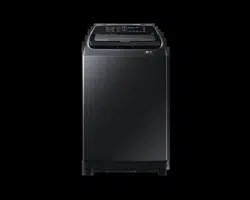Documents: Go to download!
User Manual
- User Manual - (English)
- Installation Guide - (English)
User Manual Washing Machine
Installation
What’s included
Make sure all the parts are included in the product package. If you have a problem with the washing machine or the parts, contact a local Samsung customer centre or the retailer.
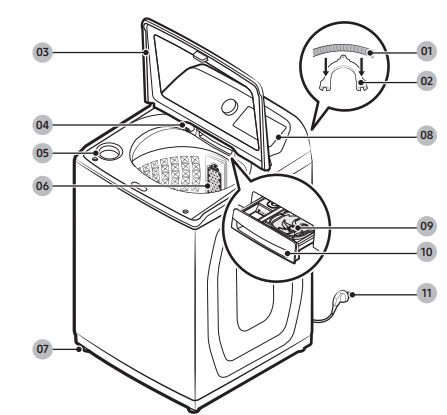
01 Drain hose
02 Hose guide
03 Lid
04 Speed Spray
05 Bleach compartment
06 Filter
07 Levelling feet
08 Control panel
09 Bubble Kit
10 Detergent drawer
11 Power cord
Installation requirements
Electrical supply and grounding
WARNING
- AC 220-240 V / 50 Hz fuse or circuit breaker is required.
- Use an individual branch circuit specific to the washing machine.
- Do NOT use an extension cord.
- Use only the power cord that comes with the washing machine.
- Do NOT connect the ground wire to plastic plumbing, gas lines, or hot water pipes.
Levelling
- To prevent tumbling or noise, install the washing machine on a solid, flat floor without a platform or bricks.
- Keep the washing machine at 10 cm from each adjacent wall.
Water supply
- Make sure water taps are easily accessible.
- Turn off the taps when the washing machine is not in use.
- Check for any leaks at the water hose fittings on a regular basis.
Drain
- Make sure the drain hose is not clogged.
- We recommend a standpipe in height of 90-100 cm. The drain hose must be connected through the hose clip to the standpipe, and the standpipe must fully cover the drain hose. The standpipe specifications mentioned here are only applicable to pump-type models.
Step-by-step installation
STEP 1 Select a location
Location requirements:
- Solid, level surface without carpeting or flooring that may obstruct ventilation
- Away from direct sunlight
- Adequate room for ventilation and wiring
- The ambient temperature is always higher than the freezing point (0 ˚C)
- Away from a heat source
Anti-rat panel (applicable models only)
The washing machine comes with the Anti-rat panel that protects small animals such as rats from entering the machine. Insert the panel into the bottom of the machine. To facilitate the work, slightly lift up the bottom front.

STEP 2 Levelling your washing machine
See if the washing machine is level by checking the position of the tub:
1. Slide the washing machine into position.
2. Open the lid of the washing machine, and pour the water into the tub to just below the pulsator level.
3. If the washing machine is level, the pulsator (A) is positioned at the centre of the washing machine as shown in the figure.
4. If the washing machine is not level, level your washing machine by turning the levelling feet clockwise or anticlockwise as necessary.

NOTE : Turn the levelling feet clockwise (B) to lower the washing machine, and anticlockwise (C) to raise the washing machine.
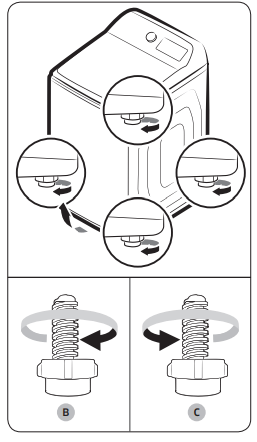
STEP 3 Connect the water hose
Connect the water hose to the water tap.
1. Remove the adaptor (A) from the water hose (B)

2. Use a Phillips screwdriver to loosen four screws on the adaptor

3. Hold the adaptor and turn part (C) in the arrow direction to loosen it by 5 mm (*).
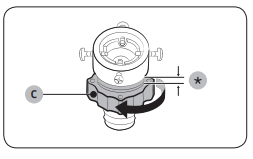
4. Insert the adaptor into the water tap, and tighten the screws while lifting up the adaptor.
5. Turn part (C) in the arrow direction to tighten it.
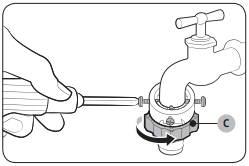
6. While holding down part (D), connect the water hose to the adaptor. Then, release part (D). The hose fits into the adaptor with a clicking sound
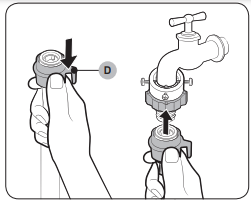
7. Connect the other end of the water hose to the inlet valve on the back of the washing machine. Turn the hose clockwise to tighten.
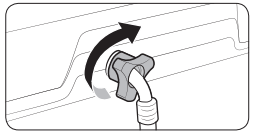
8. Open the water tap and check if there are any leaks around the connection areas.
- If there are water leaks, repeat the steps above.
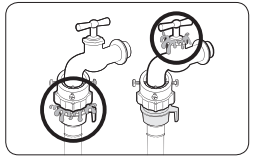
- If using a screw type of water tap, connect the water hose to the water tap as shown.
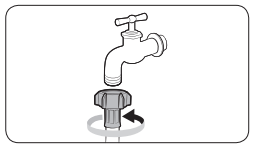
Note :
- After connecting the water hose to the adaptor, check if it is connected properly by pulling the water hose downwards.
- Use a standard type of water tap. If the tap is square-shaped or too big, remove the spacer ring before inserting the tap into the adaptor.
For models with an additional hot water inlet:
1. Connect the red end of the hot water hose to the hot water inlet on the back of the machine.
2. Connect the other end of the hot water hose to the hot water tap.
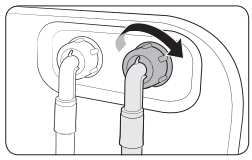
STEP 4 Position the drain hose
General type
1. Press and hold down the joint ring, and insert it into the drain hose.
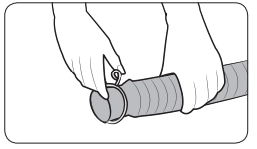
2. Insert the drain hose into the drain outlet. Make sure to connect them firmly using the joint ring. The drain hose is extensible. Adjust the length of the drain hose as needed.
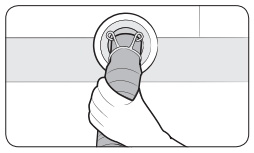
Pump type (Applicable models only)
1. Open the hose cap (A), and insert the drain hose. Tighten the drain hose using the joint ring.
NOTE
- The position (side or rear) of the drain outlet depends on the model.
- Availability of the hose cap depends on the model.
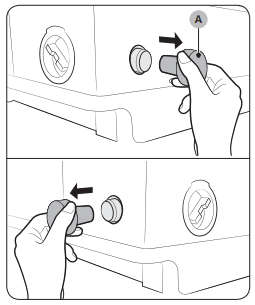
2. Connect the other end of the drain hose to a standpipe or basin that is positioned 90-100 cm (*) from the floor.
WARNING : Make sure the end of the drain hose is not submerged by water. Otherwise, the washing machine may suffer serious damage.
CAUTION :
- Do not exceed 3 m (*) for the total length of extended hoses.
- Do not let the drain hose run over doorsills that protrude 5 cm (**) or more from the floor.
- Do not run the drain hose under the bottom of the machine
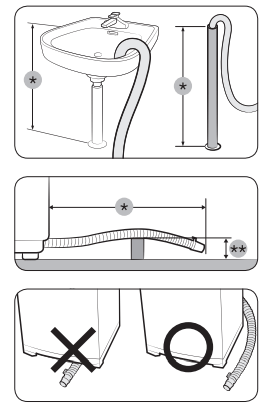
STEP 5 Power on
Plug the power cord into a wall socket featuring an AC 220-240 V / 50 Hz approved electrical outlet protected by a fuse or circuit breaker. Then, press POWER to turn on the washing machine.
STEP 6 Running a test cycle
Run a test cycle as follows to check if your washing machine is properly installed.
1. Load about 6 pounds of laundry into the tub.
2. Press POWER to turn on your washing machine.
3. Turn the Cycle Selector to RINSE+SPIN.
4. Press and hold Hold to Start to start the test cycle.
5. The washing machine should not rock or vibrate excessively when water is supplied or when washing or spinning, and should drain well during the spin cycle.
NOTE
- If water leaks while water is being supplied or drained, check the water connections. Refer to the “Connect the water hose” section on page 13 for instructions.
- If the washing machine rocks and vibrates excessively, level your washing machine again. Refer to the “Levelling your washing machine” section on page 12 for instructions.
STEP 7 Calibration Mode
Your Samsung washing machine detects the laundry weight automatically. For more accurate weight detection, please run Calibration Mode after the installation. To run Calibration Mode, follow these steps:
1. Remove laundry or any contents in the machine.
2. Press and hold Cold and Delay End simultaneously for at least 3 seconds when the power is turned on.
3. Press and hold Hold to Start to activate Calibration Mode.
4. The pulsator rotates clockwise and anticlockwise approximately 1 minute.
5. When Calibration Mode is finished, “0” appears on the display, and the washing machine automatically turns off. The washing machine is now ready for use.
Environment
Please dispose of the packaging materials for this product in an “environmentally friendly” manner. For further detail, please contact your local area authority.
Before you start
Detergent guidelines
The washing machine provides a two-compartment dispenser for detergent and fabric softener. The bleach compartment is located on the left side of the tub.
- Softener compartment (A): Add a recommended amount of fabric softener into the softener compartment.
- Detergent compartment with Bubble Kit (B): Apply a recommended amount of detergent (liquid or powder) into the compartment.
- Bleach compartment (C): Add non-chlorine bleach as instructed by the manufacturer.
NOTE
- Do not pour colour-safe bleach into the bleach compartment.
- Use the softener compartment only for liquid fabric softeners.
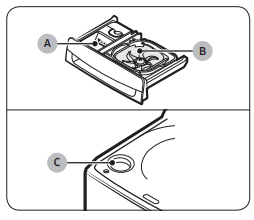
To apply detergents
1. Open the door.
2. Locate the detergent drawer, and slide it open.
3. Apply detergent (liquid or powder) into the detergent compartment.
NOTE
- Do not exceed the max line on the Bubble Kit (A) when you put detergent (liquid or powder) into the detergent compartment.
- owder detergent if the required amount of powder detergent for your laundry exceeds the bubble kit’s maximum line.
4. Add a recommended amount of non-chlorine bleach into the bleach compartment.
NOTE : Do not exceed the max line when applying the cleaning agents.
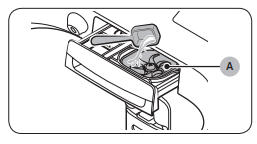
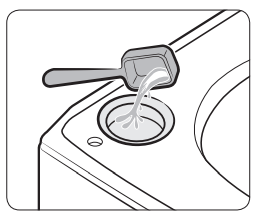
CAUTION : Do not pour undiluted liquid chlorine bleach directly onto the load or into the tub. This may cause fabric damage.
NOTE
- It is normal for a small amount of water to remain in the detergent compartments at the end of the cycle.
- When adding colour-safe bleach, it is recommended to use liquid detergent.
- Do not use liquid fabric softener that is too sticky as it may not mix with the water sufficiently.
Laundry guidelines
Checkpoints
- Check for stains or dirt. Apply a little detergent to a white towel. Rub the white towel and the dirty clothes together to transfer the dirt or colour to the white towel.
- Before washing, pre-treat the sleeves, collars, dress hems, and pockets by brushing with detergent.
- Wrinkle-processed clothes made of wool must be specially treated by tightening them with threads before washing. Remove the threads after washing and drying is complete.
CAUTION
- Do not place or keep blankets in the tub.
- Do not put candles or a heat source in or on the washing machine.
- Do not wash these clothes:
- Neckties, brassieres, jackets, suits, and coats can be easily deformed by shrinking or discolouring on the surface. These clothes are mostly made of rayon, polynosic, cuff, and/or blended fabric.
- Wrinkle-processed, embossed, or resin processed clothes easily deform merely by soaking in water.
- Clothes that are easily discoloured made from cotton, wool, wrinkled silk, leather wear and accessories, and leather ornamented clothes and accessories.
- Waterproof sheets, mattresses, or wool quilts, rain covers, fishing jackets and trousers, skiwear, sleeping bags, diaper covers, sweat suits, vehicle covers for automobiles, bicycles, and motorcycles, bath rugs, and other waterproof items.
STEP 1 Sort
Sort the laundry according to these criteria:
- Care Label: Sort the laundry into cottons, mixed fibres, synthetics, silks, wools, and rayon.
- Colour: Separate whites from colours.
- Size: Mixing different-sized items together in the tub improves the washing performance.
- Sensitivity: Follow the cloth-specific instructions on the care label of delicate items such as pure, new woollen items, curtains, and silk items.
NOTE : Make sure to check the care label on the clothing, and sort them accordingly before starting the wash.
STEP 2 Empty pockets
Empty all the pockets of your laundry items, and remove dirt and/or soils from them.
- Metal objects such as coins, pins, and buckles on clothing may damage other laundry items as well as the tub.
- Turn clothing with buttons and embroideries inside out.
- If pants or jacket zippers are open while washing, the tub may be damaged.
- Zippers should be closed and fixed with a string.
- Clothing with long strings may become entangled with other clothes. Make sure to tie the strings before washing.
STEP 3 Use a laundry net or wash certain items separately
- Brassieres (water washable) must be placed in a laundry net. Metal parts of the brassieres may break through and tear other laundry items.
- Cashmilon, large volume garments, and lightweight clothes (lace-decorated clothes, lingerie, nylon stocking, and synthetic fabrics) may float on water during washing and cause problems to the machine. Use the laundry net or wash them separately.
- Do not wash the laundry net by itself without other laundry. This may cause abnormal vibrations that could move the washing machine and result in injury.
CAUTION Make sure to soak inflatable items (such as blankets, and cotton-filled or microfibre quilets) in water before you run a cycle.
- Inflatable items may cause damage to the laundry or the machine during the wash or drying process.
- Regardless of the size, blankets or quilts are safer and cleaner to wash one item at a time. Two differentsized blankets in the same load may compromise the drying performance due to unbalanced loads.
To input a blanket
Fold the blanket as shown, and then put it on the plastic area (A) of the tub before inserting into the tub.
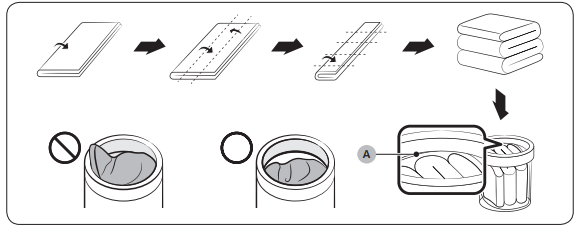
STEP 4 Prewash (if necessary)
- To remove stains and dirt on collars, sleeves, hems, and pockets, apply detergent lightly and brush off.
- Use powder or liquid detergents. Do not use soap, as this may remain on the tub after washing.
- Prewash white socks, sleeves, and collars with a little detergent and a brush.
CAUTION : Make sure the laundry is inserted completely.
- Any exposed part of the laundry may cause damage to the machine or the laundry itself, or a water leak.
- Make sure the laundry does not exceed the plastic area (A) in the above figure
STEP 5 Determine the load capacity
Make sure the laundry does not exceed the plastic area (A) in the figure on page 23. Otherwise, it may cause the washing machine to not wash properly or cause damage to the machine or the laundry itself, or a water leak.
NOTE : When washing bedding or bedding covers, the wash time may be lengthened or the spin efficiency may be reduced. For bedding or bedding covers, the recommended load capacity is 3.5 kg or less.
CAUTION : If the laundry is unbalanced and the “Ub” information code is displayed, redistribute the load. Unbalanced laundry may reduce the spinning performance and cause damage to the machine or the laundry itself.
STEP 6 Apply a proper detergent type
The type of detergent depends on the type of fabric (cotton, synthetic, delicate items, wool), colour, wash temperature, and degree of soiling. Always use “low suds” laundry detergent, which is designed for automatic washing machines.
CAUTION
- Use an appropriate amount of detergent. Excess amounts of detergent do not produce much improvement in washing results but cause damage to the laundry due to deteriorated rinsing performance.
- Bleach is strong alkali in nature, causing damage to or discolouration of the laundry.
- Use a longer or added rinse cycle when using powder detergent that is very likely to remain on the laundry and cause bad odours after washing is complete.
- If an excessive amount of detergent is used especially in cold water, the detergent doesn’t dissolve well, ending up with contaminated laundry, hoses, and/or tub.
- In case of timed washing, do not apply detergent directly to laundry or the tub. The laundry may be discoloured. Use the detergent drawer. • When washing wool using the Wool cycle, use only a neutral detergent to avoid discolouring the laundry.
NOTE
- Follow the detergent manufacturer’s recommendations based on the weight of the laundry, the degree of soiling, and the hardness of the water in your local area. If you are not sure about the water hardness, contact a local water authority.
- Do not use detergent that tends to be hardened or solidified. This detergent may remain after the rinse process, blocking the drain outlet.
- Powdered detergent should be thoroughly dissolved in a small amount of warm water before adding to the machine.
Operations
Control panel

01 Cycle Selector : Turn the dial to select a cycle.
02 Display : Displays the current cycle information and estimated time remaining, or an information code if the washing machine needs to be checked.
03 Water Level : Press to change the water level manually.
04 Wash Time : Press to adjust the wash time between 9 to 50 minutes or press and hold to start wash cycle only.
05 Rinse Times : Press to change the number of rinses (maximum 5 rinses) or press and hold to start rinse cycle only.
06 Spin Speed : Press to select a different spin speed or press and hold to start spin cycle only.
07 Temp. : Press Cold or Hot to select the desired water temperature.
• Cold: For brightly coloured, very lightly soiled items.
• Hot: For colourfast items.
08 Delay End : Press to finish the wash at a specified time. To cancel the Delay End settings, simply turn off the washing machine. You can set the Delay End time up to 24 hours.
09 Smart Check : This function enables you to check the status of the washer using a smartphone.
10 Speed Spray : Use this function to shorten the wash cycle while saving energy and water consumption.
11 Soak : Press to add soaking time at the start of a cycle for better stain removal.
12 POWER : Press to turn on/off the washing machine.
13 Hold to Start : Press and hold to start an operation, or press to stop an operation temporarily
Simple steps to start

1. Press POWER to turn on the washing machine.
2. Turn the Cycle Selector to select a cycle.
3. Change the cycle settings (water level, wash time, rinse count, and/or spinning speed) as necessary.
4. To add an option such as Delay End, press the corresponding button.
5. Press and hold Hold to Start.
To change the cycle during operation
1. Press Hold to Start to stop operation.
2. Select a different cycle, and repeat steps 2-3 above if necessary.
3. Press and hold Hold to Start again to start the new cycle.
Auto cycles


Special features
Child Lock
The Child Lock function locks the washing machine door to prevent children from climbing into and suffocating inside the tub.
Activating the Child Lock function
Press and hold Water Level and Wash Time simultaneously for approximately 3 seconds.
• When you activate the Child Lock function, the Child Lock indicator blinks.
indicator blinks.
Using the Child Lock function
If the lid is opened when the Child Lock function is on, “dC” is displayed and an alarm sounds.
- If the water level in the tub is above the safe water level, “dC” is displayed on the LED display and the washing machine starts to drain water by force after 30 seconds.
- If the water level in the tub is above the safe water level and the Child Lock function is turned on while the lid is open, “CL” is displayed on the LED display, even if the washing machine is turned off, and the washing machine drains water by force.
- When Child Lock is on and the washing machine is off, if the water in the tub is above the safe water level and the lid is opened, “CL” is displayed on the LED display. No alarm sounds, but the washing machine drains the water. When the draining operation finishes, the power automatically turns off again.
- After the compulsory drain, “CL” blinks at 1 second intervals and the washing machine enters the “CL” mode. (When the washing machine is in the “CL” mode, only the POWER button works.)
- To cancel the “CL” mode, turn the power off and then on again.
- To cancel the “dC” mode, deactivate the Child Lock function. To deactivate the Child Lock function, press and hold Water Level and Wash Time simultaneously for at least 3 seconds.
Deactivating the Child Lock function
Press and hold both Water Level and Wash Time simultaneously for approximately 3 seconds.
- When you deactivate the Child Lock function, the Child Lock
 indicator is turned off.
indicator is turned off. - The Child Lock function prevents children or the infirm from accidently operating the washing machine and injuring themselves.
WARNING : If a child enters the washing machine, the child may become trapped and suffocate.
CAUTION
- Once you have activated the Child Lock function, it continues working even if the power is turned off.
- Forcing the lid open can result in injury or damage to the product.
NOTE : To add laundry after you have activated the Child Lock function, you must first deactivate the Child Lock function.
Delay End
You can set the washing machine to finish a cycle later. The hour displayed indicates the time the wash will finish.
1. Select a cycle. Then, change the cycle settings if necessary.
2. Press Delay End repeatedly until a desired end time is set.
3. Press and hold Hold to Start. The lamp indicator next to the Delay End button turns on, and the timer starts.
4. To cancel Delay End, restart the washing machine by pressing POWER.
Real-life case
You want to finish a two-hour cycle 3 hours from now. To do this, add the Delay End option to the current cycle with a 3-hour setting, and then press and hold Hold to Start at 2:00 p.m. The washing machine starts operating at 3:00 p.m. and ends at 5:00 p.m. Provided below is the timeline for this example.

Speed Spray
Use this function to shorten the wash cycle while saving energy and water consumption. This function is only available in the NORMAL cycle.
1. Press POWER to turn on the washing machine.
2. Turn the Cycle Selector to NORMAL.
3. Press Speed Spray.
- You can set the Rinse Times option if necessary.
4. Press Hold to Start.
- The washing machine starts to detect the laundry weight. The pulsator and the tub rotate during this process.
- When the weight detection is complete, the washing machine automatically sets the water level and displays it in the control panel.
- When the water level is displayed in the control panel, press Hold to Start to pause an operation. Then, add detergent and fabric softener in the detergent drawer according to the selected water level.
5. Press and hold Hold to Start.
Alarm off
To turn the sound on or off, press and hold Speed Spray for 3 seconds.
- You can turn the sound on or off for all cycles.
- When the sound is off, turns on.
Soak
Use Soak if the laundry is heavily contaminated or stained. Soak improves the wash performance by adding a soak cycle. Soak adds 20 minutes to the cycle time. When Soak is complete, the wash cycle starts without draining water.
Smart Check
To enable this function, you must first download the Samsung Smart Washer app at the Play Store or the Apple Store, and install it on a mobile device featuring a camera function. The Smart Check function has been optimised for Galaxy & iPhone series (applicable models only).
1. When the washer detects an issue to check, an information code appears on the display. To enter Smart Check mode, press Smart Check.
2. The washing machine starts the self-diagnosis procedure and displays an information code if a problem is detected.
3. Run the Samsung Smart Washer app on your mobile device, and tap Smart Check.
4. Put the mobile device close to the washing machine’s display so that the mobile device and the washing machine face each other. Then, the information code will be recognised automatically by the app.
5. When the information code is recognised correctly, the app provides detailed information about the problem with applicable solutions.
NOTE
- The function name, Smart Check, may differ depending on the language.
- If there is strong reflected light on the washing machine display, the app may fail to recognise the information code.
- If the app fails to recognise the Smart Check code consecutively, enter the information code manually onto the app screen.
Maintenance
Cleaning
Keep the washing machine clean to prevent deteriorated performance and to preserve its life cycle.
Exterior
- Use a soft cloth to wipe up all detergent, bleach, or other spills as they occur.
- Clean the control panel with a soft, damp cloth. Do not use abrasive powders or cleaning pads. Do not spray cleaners directly on the panels.
Tub clean
Regularly run this cycle to clean the tub and to remove bacteria from it.
1. Makes sure the tub is completely empty.
2. Press POWER to turn on the washing machine.
3. Turn the Cycle Selector to TUB CLEAN. You can also use Delay End with TUB CLEAN.
4. Press and hold Hold to Start.
NOTE : If the washing machine is installed and used in a humid place, bacteria in the air may adhere to the humid surface of the tub and foster mould growth, which is harmful to your health. To keep your washing machine tub clean, use the TUB CLEAN cycle once every 1-2 months (or when the TUB CLEAN indicator turns on) to clean the tub.
CAUTION
- Only run TUB CLEAN when the tub is completely empty. This may cause damage to the laundry or a problem with the washing machine.
- Depending on the conditions and surroundings in which the washing machine is used, the degree of contamination in the tub or the result of the TUB CLEAN cycle may vary. When using the TUB CLEAN cycle, pour 200 ml of chlorine bleach evenly on the bottom of the tub.
- Excessive use of chlorine bleach may cause product malfunction. Do not mix chlorine bleach with other substances (such as vinegar, citric and oxygen bleach, etc.)
- Mixing chlorine bleach with these substances can generate harmful gas. When using chlorine bleach, make sure to ventilate the surrounding area. If you have used the washing machine for a long time without cleaning the tub or if you are cleaning the tub for the first time, some residue may remain in the tub after the TUB CLEAN cycle.
- Run an additional RINSE+SPIN cycle to completely remove residue. Though stainless tubs do not rust easily, they may get rusty in the following cases; if rust should occur, wipe them with neutral detergent on a sponge or soft cloth.
- If any metallic objects (safety pins, hairpins, etc.) that rust easily are left in the tub for a long time.
- If chlorine bleach is left in the tub for a long time.
- If an excessive amount of chlorine bleach is used in the tub.
Tub clean reminder
- The TUB CLEAN indicator reminds you of cleaning the tub when necessary. If you happen to see the indicator blinking after washing is complete, remove the laundry and run the TUB CLEAN cycle.
- You can ignore this reminder and continue to run cycles normally because this is not a system failure. However, the reminder remains active for 6 consecutive cycles immediately after each cycle is complete.
- To keep the tub clean, it is recommended to run TUB CLEAN on a regular basis.
POWER TUB CLEAN
Use this function if you have not performed the TUB CLEAN cycle or need more powerful tub cleaning performance. You can add detergent to clean the tub more thoroughly.
1. Make sure the tub is empty.
2. Press POWER to turn on the washing machine.
3. Press and hold Soak for 3 seconds. - Pour 200 ml of chlorine bleach evenly on the bottom of the tub.
4. Press and hold Hold to Start.
WARNING
- Do not put any items in the tub while running the POWER TUB CLEAN cycle. The items may get damaged or discoloured.
- Depending on the conditions and surroundings in which the washing machine is used, the degree of contamination in the tub or the result of the POWER TUB CLEAN cycle may vary.
Filter
1. Press down the upper area of the filter case to remove.

2. Unlock the cover, and clean the filter with running water and a brush.
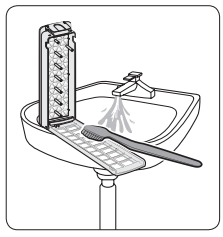
3. When cleaning is complete, close the cover and reinsert the filter case to the original position. You will hear a clicking sound when the filter case fits in.
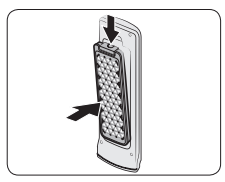
Mesh filter
1. Use pliers to pull out the mesh filter from inside the water inlet as shown.
2. Use a soft brush to clean the mesh filter with running water.
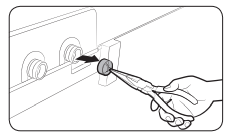
3. Reinsert the filter. Make sure it is tightened against water leaks
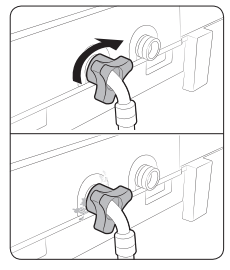
Detergent drawer
1. Fully pull out the detergent drawer.
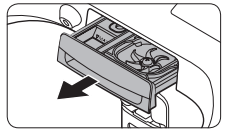
2. To remove, pull the detergent drawer while pushing the ends of each side.
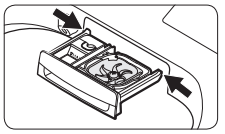
3. Remove the Bubble Kit (A) from the compartments. Rinse the Bubble Kit (A) and the drawer in warm water and clean with a soft brush.
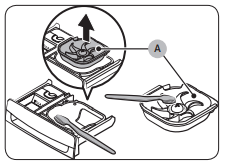
4. Clean the drawer opening thoroughly with a small, non-metallic brush.
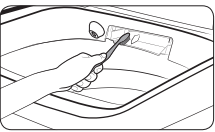
5. Return the Bubble Kit (A) to the detergent compartment. Replace the drawer by placing the drawer rail (A) on the compartment rail (B) while tilting the drawer downward.
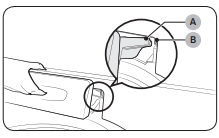
6. Fully push the drawer back to close.
Troubleshooting
Checkpoints
| Problem | Action |
| Does not turn on. |
|
| Does not start. |
|
| Water is not supplied. |
|
| After a cycle, detergent remains in the automatic dispenser. |
|
| Vibrates excessively or makes noise. |
|
| Stops. |
|
| The TUB CLEAN alarm does not turn off. |
|
| Fills with the wrong temperature water. |
|
| Door (Lid) locked or will not open. |
|
| Does not drain and/or spin. |
|
| Load is wet at the end of the cycle. |
|
| Leaks water. |
|
| Excessive suds. |
|
| The spin basket or drain/ supply hose is frozen |
|
| Water drains out immediately. |
|
| Stains on clothes |
|
| Has odours. |
|
Information codes
| Code | Action |
| 1C |
The Water Level sensor is not working properly. • Check Water Level Sensor wire harness. • If the information code remains, contact a customer service centre. NOTE When the washing machine displays “1C”, the washing machine drains for 3 minutes and the POWER button is inoperative during this time |
| 3C |
Check the motor for operation. • Try restarting the cycle. • If the problem continues, call for service. |
| 4C |
Water is not supplied. • Make sure the water taps are open. • Make sure the water hoses are not clogged. • Make sure the water taps are not frozen. • Make sure the washing machine is operating with sufficient water pressure. • Make sure that the cold water tap and the hot water tap are properly connected. • Clean the mesh filter as it may be clogged. NOTE : When the washing machine displays “4C”, the washing machine drains for 3 minutes and the POWER button is inoperative during this time. |
| 4C2 | Make sure the cold water supply hose is firmly connected to the cold water tap. If it is connected to the hot water tap, the laundry may be deformed with some cycles. |
| 5C |
Water is not draining. • Make sure the drain hose is not frozen or clogged. • Make sure the drain hose is positioned correctly, depending on the connection type. • Clean the debris filter as it may be clogged. • Make sure the drain hose is straightened all the way to the drain system. • If the information code remains, contact a customer service centre. |
| 8C |
Check the MEMS sensor. • Power off the washing machine. Wait 2-3 minutes, power on the washing machine, and then try again. • If the problem continues, call for service. |
| 9C1 |
The electronic control needs to be checked (Over Voltage Error). • Check the PCB and wire harness. • Check if power is supplied properly. • If the information code remains, contact a customer service centre. |
| 9C2 |
Low voltage detected. • Check if the power cord is plugged in. • If the information code remains, contact a customer service centre. |
| AC6 |
Inverter Communication problem. • Check the Inverter PCB and wire harness. • If the information code remains, contact a customer service centre. |
| dC dC1 |
The washing machine did not properly lock the door. • Make sure the door is properly closed. • Make sure laundry is not caught in the door. • If the information code remains, contact a customer service centre. |
| HC |
High temperature heating check. • If the information code remains, contact a customer service centre |
| LC |
Check the drain hose. • Make sure the end of the drain hose is placed on the floor. • Make sure the drain hose is not clogged. • If the information code remains, contact a customer service centre. NOTE When the washing machine displays “LC”, the washing machine drains for 3 minutes and the POWER button is inoperative during this time. |
| OC |
Water is overflowed. • Restart after spinning. • If the information code remains on the display, contact a local Samsung service centre |
| PC |
When position of the clutch can't be detected. • If the information code remains, contact a customer service centre. |
| PC1 |
After position of the clutch is detected, if the signal of the clutch hall goes wrong. • If the information code remains, contact a customer service centre. |
| Ub |
Spinning does not work. • Make sure laundry is spread out evenly. • Make sure the washing machine is on a flat, stable surface. • Redistribute the load. If only one item of clothing needs washing, such as a bathrobe or pair of jeans, the final spin result might be unsatisfactory, and an “Ub” check message will be shown in the display. |
Specification
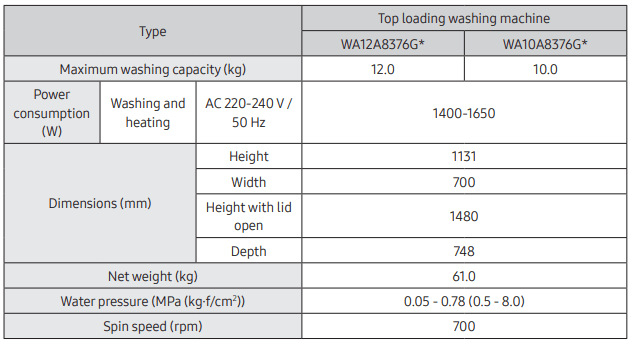
See other models: VR20M7070WS/SA GQ55Q70RGTXZG GQ75Q70TGTXZG QE55Q8FGMTXZG HW-Q90R/ZC
